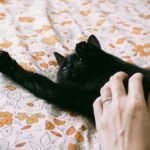Have you ever wondered what goes on in your cat’s mysterious mind? Many cat lovers know the slow process of earning a feline’s trust can feel both frustrating and magical. One day your cat is darting under the bed at the slightest sound, and the next, they’re curling up in your lap, purring contentedly. The journey from fear to trust is a beautiful transformation—one that brings joy, comfort, and a deep sense of accomplishment. But how can you be sure your cat’s fearful days are truly behind them? Let’s unravel the heartwarming signs that your cat has put their trust in you.
Approaching You Freely Without Hesitation

A cat that once hid under couches or avoided human contact may slowly begin to approach you on its own terms. This is one of the surest signs that fear has given way to trust. Watch for moments when your cat approaches you while you’re sitting quietly or even when you enter a room. Instead of retreating, they may walk up, sniff, or gently bump you with their head. This brave gesture shows your cat sees you as a friend, not a threat. If you notice they do this frequently, it’s a strong signal that their confidence in your presence has grown. Each approach is a little leap of faith from your furry companion.
Relaxed Body Language and Posture

Body language says it all in the feline world. A fearful cat typically has a tense body, with ears flattened, tail tucked, and eyes wide. In contrast, a trusting cat displays a relaxed posture: their tail might be loosely curled, their eyes half-closed, and their body stretched out or comfortably curled. If your cat flops down with their belly exposed or lounges near you in a sprawled position, it’s a clear message: I feel safe here. The more often you see this laid-back behavior, the more trust your cat is showing.
Purring and Soft Vocalizations

Purring is often a sign of contentment, and when your cat purrs in your presence, it means they associate you with good feelings. Some cats will also chirp, trill, or make other gentle sounds when they’re happy and secure. These soft vocalizations are a way for your cat to communicate their comfort and affection. If your cat greets you with a little meow or settles near you while purring quietly, it’s their unique way of saying, “I trust you.” This vocal connection can be one of the most rewarding experiences for cat owners.
Initiating Physical Contact

Cats who have left behind their fear often take the initiative to seek touch. You might notice your cat rubbing against your legs, head-butting your hand, or weaving around your ankles. These actions, known as “bunting,” are how cats mark people they trust with their scent. A cat who chooses to brush up against you is showing complete confidence in your presence. It’s a loving invitation to connect, and a sign that trust has replaced uncertainty. If you respond with gentle petting, you’ll likely strengthen this bond even further.
Following You Around the House

If your cat trails you from room to room, it’s more than simple curiosity—it’s a powerful sign of trust. Fearful cats usually keep their distance, but a cat who follows you is saying, “I want to be where you are.” Whether you’re making coffee or working at your desk, their quiet companionship shows they feel safe and want to be near you. This shadow-like behavior is both endearing and a clear indicator that your cat enjoys your company.
Playfulness and Engaging in Games

A playful cat is a happy, trusting cat. When a cat feels safe, they’re more likely to chase toys, pounce on string, or play hide-and-seek with you. Play is a vulnerable activity for cats because it requires letting their guard down. If your once-shy cat now brings you a toy or initiates a game, it’s a strong indication that trust has replaced fear. Playtime also strengthens your bond and provides a wonderful outlet for your cat’s energy.
Sleeping in Your Presence

Cats are naturally cautious about where they sleep, as they’re at their most vulnerable when dozing. If your cat chooses to nap near you or, even better, on your lap or bed, this shows tremendous trust. They feel secure enough to let their guard down and catch some z’s with you nearby. The ultimate sign? A cat who sleeps belly-up in your presence—this exposed position means they feel entirely safe.
Accepting Gentle Handling and Petting

A fearful cat may flinch, hide, or even hiss when touched. Over time, as trust develops, your cat might begin to accept gentle strokes, chin scratches, or even being picked up. Notice which areas your cat allows you to touch and pay attention to their response. If they purr, knead, or lean into your hand, it’s a good sign you’ve gained their trust. Respecting their boundaries and moving at their pace will only deepen your connection.
Showing Their Belly

The infamous belly display is a celebrated milestone for cat parents. When a cat rolls over and exposes their soft underbelly, it’s the ultimate gesture of vulnerability and trust. While not all cats enjoy belly rubs, the mere act of showing their stomach means they feel safe from harm. This trust-filled gesture is often reserved for their favorite humans—so cherish it when it happens.
Eating Comfortably Around You

A cat that eats in your presence is demonstrating that they feel safe and secure. In the wild, cats are cautious eaters, always alert for danger. If your cat happily munches away while you’re nearby, or even better, accepts treats from your hand, it’s a strong indication that they trust you completely. This relaxed eating behavior is a silent but powerful sign of growing confidence.
Grooming Themselves or You

Grooming is a private activity for most cats. If your cat starts grooming themselves while you’re near, it means they feel at ease in your company. Some cats even extend their trust by licking your hand or face—this is called “allogrooming,” and it’s how cats bond with those they love. Being the recipient of a sandpapery tongue is a high honor in the feline world and a sure sign you’ve replaced their fear with affection.
Slow Blinking in Your Direction

The “slow blink” is a subtle, magical sign of feline trust. When your cat looks at you and slowly closes their eyes, it’s like a kitty kiss. This gesture communicates relaxation and goodwill. You can even try slow blinking back—it’s a way of saying, “I love you” in cat language. If your cat returns the gesture, you’ve built a beautiful bridge of trust between you.
Minimal Startle Response to Movement or Noise

Cats who are still fearful react strongly to sudden movements or loud noises. As trust grows, you’ll notice your cat becomes calmer and less reactive. They may stay put when you walk by or simply flick an ear at a sudden sound instead of dashing away. This reduced startle response shows your cat no longer views their environment—or you—as a source of danger.
Allowing You to Enter Their Safe Spaces

Many cats have favorite hiding spots where they retreat when feeling scared. If your cat now allows you to approach or even join them in these spaces, it’s a huge step forward. Whether it’s a cozy nook under the bed or a high perch on a shelf, being invited into their sanctuary signifies deep trust. It means you are seen as a protector, not a threat.
Bringing You “Gifts”

Some cats express affection by bringing their humans “gifts”—whether it’s a toy, a leaf, or, in rare cases, a less pleasant present from outdoors. This behavior is rooted in their instincts to share resources with those they trust. If your cat drops a toy at your feet, it’s their way of involving you in their world and showing you’re part of their inner circle.
Responding to Your Voice or Name

A cat who trusts you will often respond when you call their name or speak in a gentle voice. You may notice their ears perk up, their tail flick, or even a little meow in reply. This recognition and engagement is a clear sign that your cat not only trusts you but also enjoys interacting with you. Talking to your cat regularly helps reinforce this communication and trust.
Allowing Guests in the Home Without Hiding

Some cats are naturally shy around strangers, but a cat who trusts their human may become more confident even when guests visit. Instead of immediately hiding, they might stay in the room, observe from a distance, or even greet new people. While every cat has their own comfort level, this growing confidence demonstrates that their fear is fading, thanks to the safe environment you’ve provided.
Seeking Comfort When Scared or Anxious

Perhaps the most touching sign of trust is when your cat comes to you for comfort during stressful moments. Whether it’s a loud thunderstorm, fireworks, or a trip to the vet, a cat who seeks you out during these times sees you as a source of safety and reassurance. This behavior speaks volumes about the trust you’ve built together.
Displaying Affectionate Behaviors

Cats have many ways of showing affection, including nuzzling, kneading, or curling up close to you. These behaviors are reserved for those they feel bonded to and are a heartfelt expression of trust. If your cat regularly seeks out your affection, it’s a sign they cherish your relationship and feel completely secure in your presence.
Maintaining Eye Contact Without Fear

Direct eye contact can be intimidating in the animal world, but a cat who holds your gaze without signs of anxiety is demonstrating trust. They may look at you calmly, blink slowly, or even initiate eye contact during quiet moments. This gentle, sustained gaze is a silent but powerful way your cat communicates their confidence and affection.
Greeting You at the Door

There’s nothing quite as heartwarming as coming home to find your cat waiting for you at the door. This enthusiastic greeting shows excitement, comfort, and a sense of belonging. It means your cat looks forward to your return and feels safe in your care. These joyful reunions are a beautiful testament to the trust and love you’ve built together.
Hi, I’m Bola, a passionate writer and creative strategist with a knack for crafting compelling content that educates, inspires, and connects. Over the years, I’ve honed my skills across various writing fields, including content creation, copywriting, online course development, and video scriptwriting.
When I’m not at my desk, you’ll find me exploring new ideas, reading books, or brainstorming creative ways to solve challenges. I believe that words have the power to transform, and I’m here to help you leverage that power for success.
Thanks for stopping by, Keep coming to this website to checkout new articles form me. You’d always love it!






